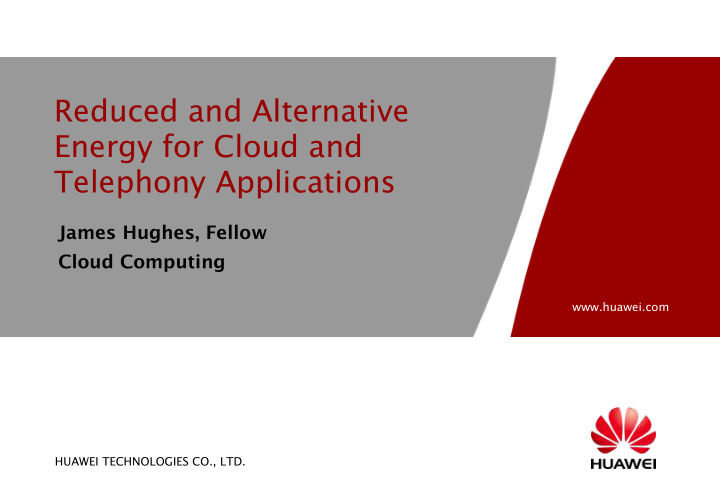



Reduced and Alternative Energy for Cloud and Telephony Applications James Hughes, Fellow Cloud Computing www.huawei.com HUAWEI TECHNOLOGIES CO., LTD.
Agenda Energy usage in a Telco Trends and direction Energy usage in data centers Total Energy Server Energy Consolidation Saving energy by selecting data center location Latency issues Promising research areas FAWN Ceph What about data center recycling HUAWEI TECHNOLOGIES CO., LTD.
Green Radio Scenarios Two Market Profiles: Developed World Developed Infrastructure Saturated Markets Quality of Service Key Issue Drive is to Reduce Costs Emerging Markets Less Established Infrastructure Rapidly Expanding Markets Large Geographical Areas Often no mains power supply power consumption a major issue Peter Grant, Green Radio – The Case for More E ffj cient Cellular Base Stations, May 2009, University of Edinburgh HUAWEI TECHNOLOGIES CO., LTD.
CO 2 emissions per subscriber Energy Cost per Subscriber per year 3 electricity use is in radio access 2.6kg 9kg dominant energy requirement at Operation CO 2 Operation vs Embodied CO 2 Data Center a small part 8.1kg Embodied CO 2 Room for improvement 4.3kg energy CO 2 Base station Base station Mobile Tomas Edler, Green Base Stations – How to Minimize CO2 Emission in Operator Networks, Ericsson, Bath Base Station Conference 2008 HUAWEI TECHNOLOGIES CO., LTD.
Base Station Power use Central Equipment Combining/Demultiplexing Power Amplifier Transceiver Power conversion Cooling Fans Transceiver Idling Power Supply Tomas Edler, Green Base Stations – How to Minimize CO2 Emission in Operator Networks, Ericsson, Bath Base Station Conference 2008 HUAWEI TECHNOLOGIES CO., LTD.
Where does the data center power go? Energy losses in the U.S. T&D system are ~7.2% Chiller 33% 1w server savings is a 3.3w Electrical Waste overall savings Humidifier 3% Power Heat IN OUT CRAC 9% Ambient cooling UPS IT Equipment 30% Indoor Data Center PDU 5% Heat UPS 18% Switchgear/generator 1% Lighting 1% http://climatetechnology.gov/library/2003/tech-options/tech-options-1-3-2.pdf http://doe.thegreengrid.org/files/temp/E12A2B5D-B0E1-CA1A-97C1553AF4A01249/Green_Grid_Guidelines_WP.pdf HUAWEI TECHNOLOGIES CO., LTD.
Economic arguments Labor Servers and Power are 70% of Networking data center TCO Facilities Servers Other IT Power Data Center 3 Year TCO http://scap.nist.gov/events/2009/itsac/presentations/day2/Day2_Cloud_Blakley.pdf HUAWEI TECHNOLOGIES CO., LTD.
Breakdown of Server Power Consumption Server Power Consumption (Source: Intel Labs, 2008) HUAWEI TECHNOLOGIES CO., LTD.
The Argument for Server Consolidation Power usage vs Processor Utilization Average server is 10% 400 Server Power Consumption utilized 300 Consolidation increases utilization 200 100 0 0 20 40 60 80 100 Server Utilization CPU Utilization and Power Consumption (Source: Blackburn 2008) HUAWEI TECHNOLOGIES CO., LTD.
: Current Profile – WRITEs n ACT= 36 RAM Power ACT WR WR PRE ACT WR WR Data In Data In Data In Energy based mostly on access 25% static power utilization RAM Dedup Reduce static power utilization Embodied Energy WRITEs 17: Power Consumption per Device 500 450 400 Device Power (mW) 350 300 Total RD/WR/Term Pow er Total Activate Pow er 250 Total Background Pow er 200 150 100 50 http://download.micron.com/pdf/technotes/ddr3/TN41_01DDR3%20Power.pdf 0 HUAWEI TECHNOLOGIES CO., LTD.
Data center location matters On how many days is cooling Harbin Urumqi necessary in each city? Assume air cooling Lanzhou Cost of electricity? Latency? Yichang Network Capacity? Shenzhen HUAWEI TECHNOLOGIES CO., LTD.
Ambient Cooling, Harbin, China Average Temperature 100 75 50 25 0 Low High Air cooling Limit -25 Jan Mar May Jul Sep Nov http://www.travelchinaguide.com/climate/harbin.htm HUAWEI TECHNOLOGIES CO., LTD.
Eliminating Transmission loss Colocate data centers with electricity generation Dams have water to cool data centers http://en.wikipedia.org/wiki/Three_Gorges_Dam HUAWEI TECHNOLOGIES CO., LTD.
Hydroelectric power Not Constant http://en.wikipedia.org/wiki/Three_Gorges_Dam HUAWEI TECHNOLOGIES CO., LTD.
Improvements in Networking 2,250 miles 24ms optical latency 130ms measured (San Francisco to Chicago) 5x improvement with AON HUAWEI TECHNOLOGIES CO., LTD.
Fast Array of Wimpy Nodes 2500 2000 Scales linearly qps (value = 100B) 1500 Using small processors 1000 High performance 500 Energy e ffj ciency qps 0 75x of a “Server” 0 2 4 6 8 10 # of fawn nodes Can Fawn nodes scale to 1000s? System QPS Watts Queries/Joule Alix 704 6 117 Can the cost of Flash be Soekris (1) 334 3.75 89 Soekris (8) 2431 30 81 competitive to disk? Desktop+SSD 2728 80 34 When? Gumstix 50 2 25 Macbook Pro 53 29 1.8 Desktop 160 87 1.8 Server 600 400 ∗ 1.2 http://www.cs.cmu.edu/~dga/papers/fawn-pdl-tr-08-108.pdf HUAWEI TECHNOLOGIES CO., LTD.
Ceph: A Scalable, High-Performance Distributed File System … Problem? File (ino,ono) oid … Objects 12 x 1TB disk server from Dell hash(oid) & mask pgid … PGs ~$8000 … … … CRUSH(pgid) (osd1, osd2) 12 x 1TB disk sells for ~$1000 750W OSDs (grouped by failure domain) Can this be reduced? Ceph uses a $100 ARM server per 2 x 1TB disks Does it scale? Can the centralized metadata server be eliminated? Reliability at scale? 180W? http://www.ssrc.ucsc.edu/Papers/weil-osdi06.pdf HUAWEI TECHNOLOGIES CO., LTD.
Recycling Average server / storage system has a 3 year life Companies like Amazon replace racks at the 3 year mark How do we reduce the embodied CO 2 ? Can we recover value from the waste? Does “Fail in place” make a di fg erence? “DESIGN FOR DISASSEMBLY TO RECOVER EMBODIED ENERGY” Buildings http://eprints.qut.edu.au/2846/1/Crowther-PLEA1999.PDF HUAWEI TECHNOLOGIES CO., LTD.
Innovation over time Moore’s law is not cause but e fg ect Doubling every 2 years is 41%/yr Feature size improvement of 19%/yr Continuous process improvement Green IT will be similar Many improvements can be made No single fundamental roadblock Energy use (by itself) has no value Increases in e ffj ciency lowers cost and increases competitiveness In a commodity market, can lower cost indicate more green? If government force manufacturers to pay recycling fee? HUAWEI TECHNOLOGIES CO., LTD.
Conclusion Energy usage in a Wireless Telco focuses on base stations Energy usage in data centers has much room for improvement Location Cooling, low transmission loss, UPS Latency Server Energy Consolidation Necessary but not su ffj cient Can more/smaller processors be an answer? Now that we know how to horizontally scale? The future for energy savings is bright HUAWEI TECHNOLOGIES CO., LTD.
Thank You www.huawei.com
Recommend
More recommend